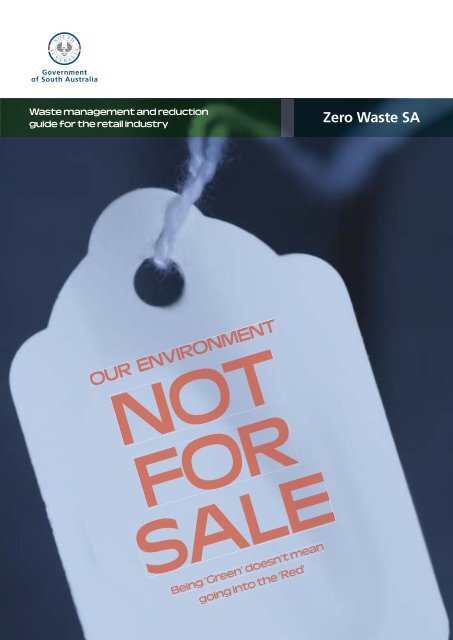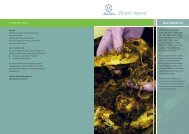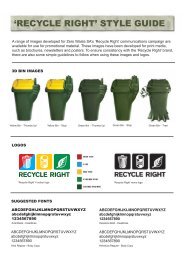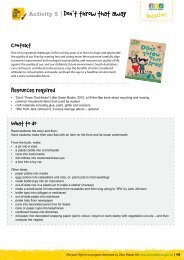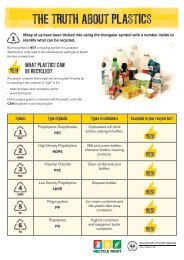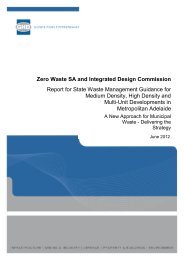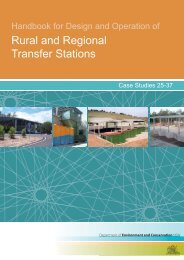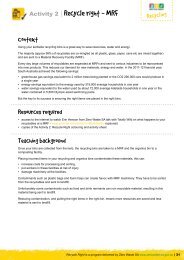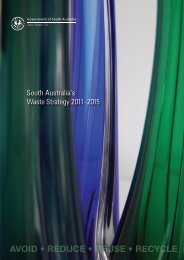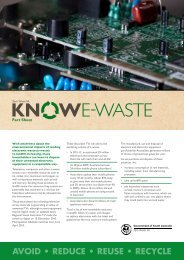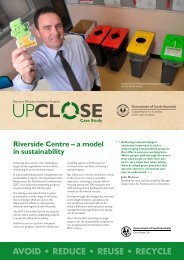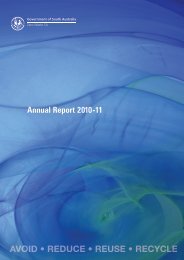Waste management and reduction guide for retail industry
Waste management and reduction guide for retail industry
Waste management and reduction guide for retail industry
- No tags were found...
You also want an ePaper? Increase the reach of your titles
YUMPU automatically turns print PDFs into web optimized ePapers that Google loves.
<strong>Waste</strong> <strong>management</strong> <strong>and</strong> <strong>reduction</strong><strong>guide</strong> <strong>for</strong> the <strong>retail</strong> <strong>industry</strong>Zero <strong>Waste</strong> SA
Published by Zero <strong>Waste</strong> SAGPO Box 1047Adelaide SA 5001Telephone 08 8204 2051Facsimile 08 8204 1911Emailzerowaste@zerowaste.sa.gov.auInternetwww.zerowaste.sa.gov.auThis document may be reproduced in whole or part <strong>for</strong> thepurpose of study or training, subject to the inclusion of anacknowledgement of the source <strong>and</strong> to its not being used <strong>for</strong>commercial purposes or sale. Reproduction <strong>for</strong> purposes otherthan those given above requires the prior written permission ofZero <strong>Waste</strong> SA.ISBN 978-921114-05-3February 2007
Businesses paying mere “lipservice” to the emerging issueof sustainability are kiddingthemselves if they expect a longfuture. While markets will againbe drawn to the headline earningsthis profit reporting season, it issustainability that requires thegreatest attention by long terminvestors.Geoff Wells, The Advertiser,15 August 2006
3Contents4.2 Reducing waste 204.3 Reuse 214.4 Recycling 224.5 <strong>Waste</strong> treatment 244.6 <strong>Waste</strong> disposal 25Section 5. Improving general environmental per<strong>for</strong>mance 265.1 Why improve general environmental per<strong>for</strong>mance? 265.2 Energy conservation 265.3 Water conservation 285.4 Stormwater <strong>management</strong> 295.5 Pollution control 305.6 Environmental purchasing 31Section 6. Marketing alternatives 326.1 Communicating effectively 33Section 7. Getting ready <strong>for</strong> the plastic bag ban 35Section 8. Conclusion 36AppendixForm 1. Example survey of <strong>retail</strong>ers 38Form 2. <strong>Waste</strong> <strong>management</strong> <strong>and</strong> recycling audit <strong>for</strong>m 40Form 3. Example shopping centre green action plan 41Form 4. Green checklist <strong>for</strong> <strong>retail</strong>ers <strong>and</strong> offices 43Form 5. Green <strong>guide</strong> <strong>for</strong> shoppers 45<strong>Waste</strong> services directory 47
4ForewordPreserving the environment is important to SouthAustralians who pride themselves on the uniquenessof their country <strong>and</strong> its wildlife.But when the media is full of stories about pollution, the climate change <strong>and</strong>the depletion of the ozone layer, it can appear too complicated <strong>for</strong> individualsto make a difference.I assure you we can. Small, seemingly insignificant actions by a large numberof concerned people can make a big difference. That’s what environmental<strong>management</strong> is really all about – a series of small decisions that cancumulatively have a big impact.All of us – centre managers, sales managers, checkout operators, customers,<strong>retail</strong>ers – have a role to play in helping preserve our environment.The benefits of managing waste better <strong>and</strong> making customers aware of ouref<strong>for</strong>ts extend to bottom lines <strong>and</strong> corporate profiles.This <strong>guide</strong> has been developed with the assistance of the SA Retail PropertyGroup (Property Council of Australia) <strong>and</strong> the State Retailers Association ofSA. This <strong>industry</strong> support <strong>and</strong> feedback has been invaluable in ensuring thatthe principles outlined in this <strong>guide</strong> are practical <strong>and</strong> take into account therealities of today’s competitive <strong>retail</strong> environment.The actions described in this <strong>guide</strong> will work just as well <strong>for</strong> individuals asthey do at the corporate level. If you take them your operation, no matter howbig or small, will reduce its impact on the environment.I commend this <strong>guide</strong> to you <strong>and</strong> ask that every day, when you are makingdecisions, keep the environment in mind because it is your actions that willmake Australia a better place <strong>for</strong> all.Gail GagoMinister <strong>for</strong> Environment <strong>and</strong> Conservation
5About this <strong>guide</strong>Strategic policy advice<strong>and</strong> direction to business<strong>and</strong> <strong>industry</strong>This <strong>guide</strong> <strong>for</strong> shopping centres is part of Zero <strong>Waste</strong> SA’scharter to provide strategic policy advice <strong>and</strong> direction tobusiness <strong>and</strong> <strong>industry</strong> which promotes waste <strong>management</strong>practices that reduce waste consigned to l<strong>and</strong>fill.The <strong>guide</strong> aims to:■ provide ways to maximise waste <strong>reduction</strong> initiatives <strong>and</strong> theimplementation of recycling opportunities to reduce the amountof waste being deposited to l<strong>and</strong>fill■ help <strong>industry</strong> control its waste <strong>management</strong> activities economically<strong>and</strong> effectively with practical <strong>and</strong> appropriate working examples <strong>for</strong>systematic waste <strong>reduction</strong>■ help shopping centres <strong>and</strong> <strong>retail</strong>ers to effectively <strong>and</strong> economicallymanage the environmental impacts of their operations■ provide a framework <strong>for</strong> meeting environmental challenges <strong>and</strong>improving efficiency.This user friendly <strong>guide</strong> is the basis <strong>for</strong> a consistent approach to waste<strong>reduction</strong> within shopping centres <strong>and</strong> the <strong>retail</strong> <strong>industry</strong> in general. Itshould complement current business plans within shopping centresthroughout South Australia.
6Who can benefitfrom this <strong>guide</strong>?The shopping centre <strong>industry</strong> is oneof the largest manufacturers of waste,<strong>and</strong> it is imperative that we implementenvironmental programs to reduceimpacts on l<strong>and</strong>fill <strong>and</strong> save water.This <strong>guide</strong> is intended as a tool <strong>for</strong> shopping centre<strong>management</strong>, commercial property owners <strong>and</strong>property managers who may be involved with planning<strong>and</strong> implementing waste <strong>reduction</strong> <strong>and</strong> recyclingprograms within shopping centres.Take up the challenge ofimplementing Environmental BestPractice in your centre <strong>and</strong> preserveour resources <strong>for</strong> future generations.Kate KnightSA Retail Property GroupGenerally waste <strong>management</strong> services are a cooperative approach between<strong>management</strong> <strong>and</strong> <strong>retail</strong>ers. Thus <strong>management</strong> is likely to play a leadership rolein any waste <strong>reduction</strong> <strong>and</strong> recycling initiatives. However, waste prevention ona large scale is a joint ef<strong>for</strong>t between <strong>retail</strong>ers <strong>and</strong> centre <strong>management</strong>.The examples <strong>and</strong> case studies in this <strong>guide</strong> can help both shopping centresoverall <strong>and</strong> individual <strong>retail</strong> businesses within the centre, to reduce waste.I think that the issue of sustainability is fast becoming important to allgenerations of Australians. The uptake of re-useable plastic bags bythe population has shown that given sound positive in<strong>for</strong>mation thepublic will respond.There are so many areas of pollution in our environment that we cannotcontrol <strong>and</strong> need Governments to take a leadership role, but it is my belief thatthe community is fast sending a message to our leaders that we will support<strong>and</strong> embrace any changes in our activity that will benefit the environment.This sustainability <strong>guide</strong> is one such document that supports that end.Ineffective waste disposalhas a negative effect on ourenvironment. A cooperativeapproach within the <strong>retail</strong> <strong>industry</strong>to efficient waste <strong>reduction</strong> <strong>and</strong>resource recovery can minimiseor negate that impact. This <strong>guide</strong>can assist SA’s <strong>retail</strong> <strong>industry</strong>to introduce effective waste<strong>reduction</strong> <strong>and</strong> <strong>management</strong>approaches to assist the principleof a sustainable future <strong>for</strong> all.I commend this <strong>guide</strong> to all inthe <strong>retail</strong> <strong>industry</strong>.Max Baldock President, StateRetailers Association of SouthAustraliaMike HaywoodPresident <strong>Waste</strong> Management Association of Australia (SA Branch)
7What can youlearn fromthis <strong>guide</strong>?This <strong>guide</strong> does not attempt to provide a ‘one size fitsall’ answer to introducing waste <strong>reduction</strong> <strong>and</strong> recyclingprograms <strong>for</strong> everyone involved in the <strong>retail</strong> <strong>industry</strong>. Itintends to provide general concepts <strong>and</strong> opportunitiesto consider in planning <strong>and</strong> launching an effective <strong>and</strong>ongoing program.Shopping centre managers <strong>and</strong> operational staff can use in<strong>for</strong>mation in this<strong>guide</strong> to determine the appropriate scope <strong>and</strong> design of their waste <strong>reduction</strong><strong>and</strong> recycling program, based on the situation within their own centre.Individual <strong>retail</strong>ers can also determine waste <strong>reduction</strong> initiatives whenassessing their own waste generation practices as part of the centre’s overallcoordinated approach to waste minimisation.Where to go <strong>for</strong> helpThe waste services directory at the end of this <strong>guide</strong>(page 47) lists organisations, with contact details, thatoffer waste <strong>management</strong> <strong>and</strong> recycling services.
8About Zero<strong>Waste</strong> SAZero <strong>Waste</strong> SA is part of the Environment <strong>and</strong>Conservation Portfolio. It has the primary objective ofpromoting waste <strong>management</strong> practices that, as far aspossible, eliminate waste or its consignment to l<strong>and</strong>fill,<strong>and</strong> advance the development of resource recovery <strong>and</strong>recycling. These objectives are based on an integratedstrategy <strong>for</strong> South Australia.South Australia’s Strategic Plan includes a goal to ‘reduce waste to l<strong>and</strong>fill by25% within 10 years’ – that is, by 2014. Zero <strong>Waste</strong> SA is the key to achievingthat goal <strong>and</strong> has outlined how we as a community can achieve this <strong>reduction</strong><strong>and</strong> other targets in South Australia’s <strong>Waste</strong> Strategy 2005–2010.The functions of ZWSA are prescribed in the Zero <strong>Waste</strong> SA Act 2004 <strong>and</strong>include the development <strong>and</strong> implementation of government policies onwaste <strong>management</strong>, raising public <strong>and</strong> <strong>industry</strong> awareness about waste<strong>management</strong>, programs <strong>for</strong> preventing litter <strong>and</strong> illegal dumping, <strong>and</strong> thedevelopment of markets <strong>for</strong> recovered resources <strong>and</strong> recycled materials.Further in<strong>for</strong>mationFor further in<strong>for</strong>mation about Zero <strong>Waste</strong> SA please visitwww.zerowaste.sa.gov.au
9Section 1.A demonstrated commitment to sound environmentalpractices <strong>and</strong> increased sustainability is part ofgenerally accepted corporate social responsibilityincreasingly dem<strong>and</strong>ed by the community,shareholders <strong>and</strong> other stakeholders.Background todeveloping awaste <strong>reduction</strong>programEnvironmental improvement approaches are seen as an essential tool toassist business to maintain regulatory compliance, improve productivity <strong>and</strong>develop a competitive advantage.The increasing numbers of businesses focusing their attention on improvingenvironmental aspects of their operations are realising that beyond theenvironmental advantages there are tangible benefits to their bottom line.Shopping centres are in a position to play a major role in providing abetter environment <strong>for</strong> future generations as well as meeting communityexpectations through improving environmental per<strong>for</strong>mance, in particularby introducing effective waste <strong>reduction</strong> <strong>and</strong> recycling programs.In developing a waste <strong>reduction</strong> program, shopping centres are able toposition themselves as organisations that care <strong>for</strong> the community <strong>and</strong>the environment.From a marketing perspective, the ‘green’ shopping centre appeals toexisting customers, <strong>and</strong> to the discerning <strong>and</strong> exp<strong>and</strong>ing ‘green’ consumermarket. Future customers become familiar with the centre’s philosophythrough support of environmental education activities within schools in thecentres’ target regions.
10Section 2.Benefits of wasteminimisation systemsAustralia has a population of around 20 million people, most of whom live in capital ormajor cities close to the eastern <strong>and</strong> southern seaboards. Each year, about 1 tonne ofwaste per person is generated – that’s 20 million tonnes of waste from commercial,industrial <strong>and</strong> domestic sources.And much of it is disposed of in l<strong>and</strong>fills.Cooperation between all levels of government, business, <strong>industry</strong> <strong>and</strong> thecommunity is necessary to achieve, effectively <strong>and</strong> cooperatively, systems tominimise <strong>and</strong> recycle waste, <strong>and</strong> reach national waste minimisation goals.2.1 What does the community think about waste?Community concern <strong>for</strong> environmental issues, <strong>and</strong> in particular waste<strong>reduction</strong>, shows no signs of abating. The community is now muchmore aware <strong>and</strong> has a deeper underst<strong>and</strong>ing of the complexities ofwaste <strong>reduction</strong> (Working with the community, October 2005,www.zerowaste.sa.gov.au/market_research.php).With the community requesting a <strong>reduction</strong> in excess packaging <strong>and</strong> morerecycling, many local government organisations haveintroduced kerbside recycling schemes <strong>and</strong> <strong>industry</strong>has introduced methods to reduce packaging <strong>and</strong>address other environmental issues.
112.2 Change from waste disposal to waste minimisationThis <strong>guide</strong> identifies methods to follow as shopping centres see the need to movefrom the present system of operation, primarily emphasising disposal, to a newapproach embracing resource conservation, waste <strong>reduction</strong> <strong>and</strong> minimisation.The development of waste minimisation approaches allows a shopping centreto review current practices, comply with statutory regulations <strong>and</strong> its owninternal requirements, <strong>and</strong> review manufacturer’s packaging methods.The shopping centre thus identifies opportunities to improve environmentalper<strong>for</strong>mance by reducing resource consumption <strong>and</strong> the amount of wasteproduced – <strong>for</strong> environmental, economic <strong>and</strong> social benefit.Section 2.Benefits of wasteminimisationsystems2.3 What are the benefitsof minimising waste?Producing waste within a <strong>retail</strong>environment negatively impactson everyone who operates withina centre’s ‘bottom line’. Goodwaste <strong>management</strong> is goodbusiness <strong>management</strong>.The benefits go beyond reducingwaste to l<strong>and</strong>fill. Preventing wastenot only saves resources <strong>and</strong> reducespollution, it also saves money.Overall benefitsAn effective waste <strong>reduction</strong>program develops a competitiveadvantage by improving overall<strong>management</strong> per<strong>for</strong>mance, improvesemployee morale, reduces operatingcosts <strong>and</strong> is in line with principles ofbest practice operating methods.Centres with an effective wasteminimisation <strong>and</strong> <strong>management</strong>program are seen as responsible,caring corporate citizens, sensitiveto environmental issues – <strong>and</strong> canattract customers who favour a‘green’ image.Other benefits include:■ improved compliance withenvironmental regulations■ better use of resources■ savings from waste minimisation<strong>and</strong> reduced disposal costs■ enhanced public image■ increased profits.Economic benefitsAn effective waste minimisation<strong>and</strong> <strong>management</strong> program canreduce the amount of waste beingsent to l<strong>and</strong>fill by over 60% (CentroColonnades Shopping Centre, 1995).Savings on collection <strong>and</strong> disposalcosts can then be offset against thecost of initiating waste minimisation<strong>and</strong> <strong>management</strong> programs.Disposal costs can only rise asl<strong>and</strong>fill sites become harder to find<strong>and</strong> further from city centres. Muchhigher operating st<strong>and</strong>ards, <strong>and</strong>thus increased costs, as well asrestrictions on the types of wastethat can be sent to l<strong>and</strong>fill, are nowexpected. A cooperative approachis the key to reducing costs.As suppliers <strong>and</strong> producersrespond to ‘green’ pressure <strong>and</strong>streamline their systems to minimisepackaging <strong>and</strong> waste, their costsshould also decrease.The many potential benefitsto be gained from minimisingwaste can only be realised byidentification of all costs associatedwith existing disposal systems,including hidden costs.
12Social benefitsMinimising waste is an ideal wayto rein<strong>for</strong>ce existing communityattitudes <strong>and</strong> current environmentalawareness <strong>and</strong> education programs,particularly in local government <strong>and</strong>the education system.Market research consistentlyshows that concern <strong>for</strong> theenvironment rates highly within thecommunity. <strong>Waste</strong> minimisation <strong>and</strong><strong>management</strong> programs are seen bymany as an ideal opportunity to dosomething <strong>for</strong> the environment.<strong>Waste</strong> minimisation <strong>and</strong> <strong>management</strong>programs can there<strong>for</strong>e create goodwillwithin the community, <strong>and</strong> thusopportunities <strong>for</strong> centres <strong>and</strong> <strong>retail</strong>ersto promote their ‘green image’.The community’s awareness of thenatural <strong>and</strong> built environment canbe raised by involving them in aprogram they perceive as helpingthe environment. It could be assimple as this: a campaign to involvecustomers in a shopping centre’srecycling program could mean lesslittering in <strong>and</strong> around the centre- <strong>and</strong> a lower cleaning budget <strong>for</strong>the centre.Materials recovery <strong>and</strong> treatmentcan be labour intensive, so theintroduction of a waste minimisation<strong>and</strong> <strong>management</strong> program has thepotential to create employment atthe local level. As the <strong>retail</strong> <strong>industry</strong>develops programs to complywith legislation, such as EPA’sWater Quality Policy <strong>for</strong> stormwaterpollution prevention, it cantake advantage of the idealopportunities to further relationshipswith the local council <strong>and</strong> StateGovernment agencies.Environmental benefitsMinimising waste conservesresources.Conserving resources not onlyreduces waste; it can reducepollution. As <strong>industry</strong> consumesfewer raw materials, it uses lessfossil fuel <strong>and</strong> less pollution isthe result.At present most solid waste ends upin l<strong>and</strong>fill. Specific risks associatedwith l<strong>and</strong>fill sites are now betterunderstood. An effective wasteminimisation <strong>and</strong> <strong>management</strong>program can take a proactiveapproach to lessening shoppingcentres’ impact on the environment.Section 2.Benefits of wasteminimisationsystems
13Section 3.How to introduce a waste<strong>reduction</strong> programThe success of a waste minimisation <strong>and</strong> <strong>management</strong>program hinges on an effective coordinating ‘eco/greenaction’ group (let them pick their own name), <strong>and</strong> on peoplewithin centres, both <strong>management</strong> <strong>and</strong> <strong>retail</strong>ers, beingsupportive <strong>and</strong> committed to minimising waste.3.1 Establishing an eco/green action groupThe best waste <strong>reduction</strong> results will come from people having a strong senseof participation, cooperation <strong>and</strong> consultation in the program’s <strong>for</strong>mulation<strong>and</strong> implementation. The people concerned manage the environmental issues<strong>and</strong> the program directly reflects their priorities <strong>and</strong> needs.Ideally, the coordinating group would comprise a mix of centre <strong>management</strong><strong>and</strong> tenants. It can contain members of centre <strong>management</strong>, in particular theoperations manager, staff from the marketing area, <strong>and</strong> invited <strong>and</strong> interested<strong>retail</strong>ers. It may be appropriate that staff from the centre’s waste <strong>management</strong>organisation could also be invited to be part of the group. Policy developmentthat is ‘owned’ by both centre <strong>management</strong> <strong>and</strong> the centre’s <strong>retail</strong>ers will notbe perceived as being a ‘centre <strong>management</strong>-driven’ initiative.CASE STUDYCentro Colonnades’ ECO group continues to look at ways to encourage <strong>and</strong>recognise environmental education initiatives within the community. Thisincludes nurturing links with local schools <strong>and</strong> community groups who areactive contributors to environmental projects through the centre’s ECOFundsupport program. This provides a focus within the centre to promote theiractivities as well as continuing to <strong>for</strong>m strong partnerships within the centre’starget areas.
14An eco corner can promote environmental initiativesSection 3.How to introducea waste <strong>reduction</strong>program3.2 Eco/green action group facilitatorA facilitator needs to be elected from the group <strong>and</strong> may be from centre <strong>management</strong>, or as agreed. The role is to setagendas, record deliberations <strong>and</strong> generally coordinate the determinations agreed in meetings.3.3 Eco/green action group meetingsThe group will only be successful if meetings are well organised, short <strong>and</strong> at a time convenient to all members.Keep in mind that <strong>retail</strong>ers <strong>and</strong> centre <strong>management</strong> staff have other tasks to per<strong>for</strong>m:■ Keep meetings to half an hour or less.■ Conduct meetings on a less busy trading day <strong>and</strong> in a quiet period, such as mornings from 8.30 am, or as agreedby group members.3.4 CommunicationDevelopment of the waste <strong>reduction</strong> program will only be successful with good, clear communications:■ Provide a record of discussions to members of the group at least a week be<strong>for</strong>e the next meeting.■ Use the centre’s in-house newsletter to advise <strong>retail</strong>ers of issues being addressed by the group.■ Arrange a monthly ‘eco column’ through a local suburban media organisation in the <strong>for</strong>m of ‘advertorial’to promote issues being h<strong>and</strong>led by the shopping centre <strong>and</strong> <strong>retail</strong>ers.■ Set up a display area within the centre to in<strong>for</strong>m shoppers about improved environmental per<strong>for</strong>mance.■ Ask local schools or environmental groups to participate in the promotion of positive environmental action<strong>and</strong> activities.■ For other marketing opportunities see section 6.
15Section 3.How to introduce a waste<strong>reduction</strong> programSteps to set up a shopping centre waste <strong>reduction</strong> programEstablish an eco/green groupThe waste <strong>reduction</strong> program development recognises that the best results will come from people having a strong senseof participation, ownership <strong>and</strong> consultation in its <strong>for</strong>mulation <strong>and</strong> implementation. There<strong>for</strong>e, managing environmentalissues will be determined by the people concerned <strong>and</strong> directly reflecting their priorities <strong>and</strong> needs.Eco/green group meetingsIf the eco/green group is to be successful, meetings need to be well organised, short <strong>and</strong> at a time convenient to all members.Initial tasks to be undertaken by eco/green groupDetermine a vision <strong>and</strong> terms of reference <strong>for</strong> the eco/green group.Set objectives.Consult with <strong>and</strong> survey <strong>retail</strong>ersSurveying also provides a mechanism <strong>for</strong> ‘one on one’ communication with <strong>retail</strong>ers as well as an opportunity<strong>for</strong> feedback to be gained from within their own premises.Audit current situationUndertake an audit to help establish which topics require action, who is responsible, <strong>and</strong> where <strong>and</strong> when the activitytakes place.With this data, as well as feedback from <strong>retail</strong>ers, the eco/green group should be in a position to prioritise action.Develop an action planDevise an action plan to ensure the program is managed efficiently. The plan needs to identifya timeframe, monitor progress, identify resources, determine a budget <strong>and</strong> set up an evaluation process.Review positionMonitor <strong>and</strong> evaluate the program to identify strengths <strong>and</strong> weaknesses, monitor per<strong>for</strong>mance <strong>and</strong> ensureaccountability - <strong>and</strong> reveal future directions.
16Section 3.How to introducea waste <strong>reduction</strong>program3.5 Determining a vision <strong>and</strong> terms of reference <strong>for</strong>the eco/green groupA vision <strong>and</strong> terms of reference <strong>for</strong> the group will help its members, <strong>and</strong> thepublic, underst<strong>and</strong> the waste <strong>reduction</strong> development process. This alsoshows the group is not merely a marketing exercise <strong>and</strong> encourages supportfrom, <strong>for</strong> example, Zero <strong>Waste</strong> SA, Environment Protection Authority, othergovernment agencies, KESAB, schools <strong>and</strong> environmental groups.Example vision <strong>for</strong> green action groupTo add a comprehensive environmental focus to a centre’s <strong>retail</strong> <strong>and</strong><strong>management</strong> operations <strong>and</strong> to raise community awareness of generalenvironmental issues through a range of educational <strong>and</strong> promotionalactivities within the centre.Example terms of reference <strong>for</strong>green action groupThe group will:■ become familiar with the basicprinciples of ecologicallysustainable development (ESD)(see definitions below)■ be familiar with the process ofdeveloping a waste <strong>reduction</strong>program <strong>for</strong> the centre■ set priorities <strong>for</strong> issues that affectthe centre <strong>and</strong> its stakeholders■ establish baseline data <strong>for</strong>current issues in the centre■ set objectives to achieve thegroup’s vision■ arrange action plans toimplement <strong>and</strong> evaluatethe policy■ ensure the process is ongoing<strong>and</strong> reviewed regularly■ be aware that <strong>retail</strong>ers in shoppingcentres are in a continuousstate of change. New tenants<strong>and</strong> staff need to be inducted<strong>and</strong> fully in<strong>for</strong>med of policies<strong>and</strong> if interested, be given theopportunity to participate in theaction group.ESD definition‘Sustainable development isdevelopment that meets the needsof the present without compromisingthe ability of future generations tomeet their own needs.’(Our Common Future: The WorldCommission on Environment<strong>and</strong> Development,G. Brundtl<strong>and</strong>, ed., 1987).Australia’s National Strategy<strong>for</strong> Ecologically SustainableDevelopment (1992) defines ESDas ‘using, conserving <strong>and</strong> enhancingthe community’s resources so thatecological processes, on whichlife depends, are maintained, <strong>and</strong>the total quality of life, now <strong>and</strong> inthe future, can be increased’.
17Section 3.How to introduce a waste<strong>reduction</strong> program3.6 Setting objectivesEstablish a range of objectives <strong>for</strong> thewaste <strong>reduction</strong> program. Priorities<strong>for</strong> minimising waste include:■ avoiding waste, which ineffect targets consumerbehaviour <strong>and</strong> purchasingchoices <strong>and</strong> promotes cleanerproduction initiatives■ reusing resources includingrefilling containers■ introducing effective recyclingprograms.Example objectives <strong>for</strong> ashopping centre■ Adopt <strong>and</strong> apply the principlesof ESD■ Adopt the best environmentalst<strong>and</strong>ards available in all aspectsof centre operations■ Strive to minimise the use of allmaterials, supplies <strong>and</strong> energy,<strong>and</strong> wherever possible userenewable or recyclable materials■ Minimise waste produced <strong>and</strong>aim <strong>for</strong> ‘waste-free’ processes■ Encourage <strong>and</strong> expect similarenvironmental st<strong>and</strong>ards fromall suppliers, vendors <strong>and</strong>contractors to the centre■ Effectively market the centre’senvironmental position■ Encourage <strong>retail</strong>er involvementin environmental action■ Communicate regularly withthe local community■ Continuously assess theenvironmental impact of allthe centre’s operations■ Raise community awarenessof general environmentalissues through a range ofeducational <strong>and</strong> promotionalactivities within the centre incooperation with recognisedenvironmental organisations.3.7 Consulting with <strong>and</strong>surveying <strong>retail</strong>ersA survey or personal contact willascertain whether <strong>retail</strong>ers haveideas or suggestions <strong>for</strong>, or concernsabout, establishing a waste <strong>reduction</strong>program. Some <strong>retail</strong>ers or areas inthe centre might already be usingsome great examples of goodenvironmental practice – it could bethe use of environmentally friendlycleaning products, or reuse orrecycling of materials.Surveying also provides amechanism <strong>for</strong> effectivecommunication with <strong>retail</strong>ers<strong>and</strong> feedback from them. Theappendix has an example of asurvey <strong>for</strong>m (Form 1).3.8 AssessmentproceduresAn audit or assessment of currentwaste <strong>management</strong> practices at theshopping centre will help establishwhich areas require action, who isresponsible, <strong>and</strong> where <strong>and</strong> whenthe activity takes place.Assessed elements should includewaste <strong>management</strong> <strong>and</strong> minimisation,education <strong>and</strong> training as wellas marketing opportunities. Theappendix has an example of anaudit <strong>for</strong>m (Form 2).
18Section 3.How to introduce a waste<strong>reduction</strong> program3.9 Developing an action plan <strong>and</strong> setting prioritiesThe objectives, feedback from <strong>retail</strong>ers <strong>and</strong> assessment data are the ingredients <strong>for</strong> the eco/green action group todetermine actions <strong>and</strong> prioritise them in an action plan.An action plan ensures the waste <strong>reduction</strong> program is efficiently managed. The plan identifies a timeframe,monitors progress, identifies resources, determines a budget <strong>and</strong> sets up an evaluation process.A typical action plan is included in the appendix (Form 3).Action plan issues<strong>Waste</strong> minimisation <strong>and</strong> recycling■ Office systems■ Paper <strong>and</strong> cardboard■ Plastics■ PET bottles <strong>and</strong> containers, cans <strong>and</strong> glass■ Compostible material■ Grease arrestors■ Toxic or hazardous materials■ Public systemsCommunity <strong>and</strong> <strong>retail</strong>er education■ Marketing alternatives■ Schools program■ Eco corner/centre in centres■ Internal communications■ External communications■ Developing opportunities topromote positive achievements
19Introducing the waste <strong>management</strong> hierarchyThe waste <strong>management</strong> hierarchy is an ordered sequence of initiatives thatcan be used to identify steps to reduce waste within a shopping centre. Its 7levels move from preferred at the top to least referred at the bottom. Avoidingwaste is the most desirable option in the hierarchy with the disposal of wastebeing the least-preferred option.Section 4.Identifying wasteminimisationopportunitiesMost PreferrableAVOIDREDUCEREUSERECYCLERECOVERTREATMENTDISPOSALLeast PreferrableAVOID: not producing/purchasingmaterials which will become wasteREDUCE: producing/purchasingless materials which willbecome wasteREUSE: using materials morethan once be<strong>for</strong>e recycling ordisposing of themRECYCLE: remanufacturingused materials into newproducts/resourcesRECOVER: capturing otherwisewasted resources (e.g. recovering<strong>and</strong> using heat from electricitygeneration processesTREATMENT: treating materials tominimise harmful effects on l<strong>and</strong>,water or airDISPOSAL: releasing materials/pollutants to l<strong>and</strong>, water or air
204.1 Avoiding waste(most preferred)Complete removal of components orpackaging from production; changesto production processesPotential waste areasProduct design■ Where possible, encouragechange in product design toreduce materials consumptionPackaging/materials■ Avoid the need <strong>for</strong> plasticshrink wrapping■ Encourage suppliers to providecrates instead of pallets■ Negotiate with suppliers toremove unnecessary packagingfrom products■ Encourage <strong>retail</strong>ers to useproducts made of recyclablematerial <strong>and</strong> packaged inrecycled materialGarden design■ Create mulched gardens insteadof lawns around centres■ Use native plants to reducewater useWays to avoid wasteOffer alternatives■ Encourage the use of reusable<strong>and</strong> refillable productsEducate/raise awarenessIn partnership with recognisedenvironmental organisationsorganisations such as KESAB:■ arrange community awarenesspromotions on waste streams<strong>and</strong> public action■ introduce displays of availablereusable <strong>and</strong> recycled products<strong>for</strong> <strong>retail</strong>ers <strong>and</strong> shoppers4.2 Reducing wasteChanges to a product or processto reduce the waste it produces orgeneratesPotential waste areasProduct design■ Encourage manufacturers tochange product design in orderto use fewer materialsPackaging/materials■ Encourage suppliers <strong>and</strong> <strong>retail</strong>ersto use only as much wrapping orpackaging material as required■ Discourage the use ofpolystyrene boxes <strong>and</strong> filling■ Reuse cardboard boxes be<strong>for</strong>epurchasing new ones■ Encourage the use of reusableplates <strong>and</strong> cutlery in food courts■ Use signs as a reminder toreduce waste <strong>and</strong> recycle.Potential savingsEnergy savings■ When purchasing newequipment, select the mostenergy efficient item■ Adjust timing switches to suitseasonal needs■ Evaluate public lighting areas■ Use energy efficient lightingWater savings■ Check <strong>for</strong> dripping taps <strong>and</strong>faulty cisterns■ Encourage the use ofenvironmentally preferred <strong>and</strong>/orbiodegradable cleaning agentsSection 4.Identifying wasteminimisationopportunitiesMaterials savingsIn the office introduce proceduresthat limit waste:■ encourage the use of recycledpaper■ organise collection of officepaper <strong>for</strong> recycling■ print documents on both sidesof paper■ reuse the blank side of used paper<strong>for</strong> notes or in-office memos■ recycle used print/copycartridges■ reduce paper use by using email■ limit printouts to necessaryitems only.In the shopping centre■ provide in<strong>for</strong>mation to <strong>retail</strong>ers<strong>and</strong> shoppers to encouragesupport <strong>for</strong> waste <strong>reduction</strong>A green checklist <strong>for</strong> <strong>retail</strong>ers (Form4) <strong>and</strong> a green <strong>guide</strong> <strong>for</strong> shoppers(Form 5) can be foundin the appendix.
21Section 4.Identifying wasteminimisation opportunities4.3 ReuseFeatures enabling a product to be reused many times, such as more durablerefill packs <strong>and</strong> reusable containersReuse initiativesPackaging/materials■ Encourage suppliers to provide rigid plastic crates as alternative todisposable cardboard boxes■ Identify <strong>and</strong> encourage suppliers/<strong>retail</strong>ers to reuse cardboard boxesor other ‘waste’ productsOrganic materials■ Ensure trimmed branches from the centre’s gardens are mulched<strong>and</strong> reused as surface mulch or compost■ Encourage, where possible <strong>and</strong> practicable, systems to remove organicmaterials from waste stream (in-vessel organic systems dramaticallyreduce the amount of putrescible waste to l<strong>and</strong>fill)CASE STUDYCentro Colonnades is the firstshopping centre in Australia tointroduce a Peat’s Soil BiobiNorganic system. Discarded fruit,vegetable <strong>and</strong> other organicmaterials are stored onsite asan alternative to disposal tol<strong>and</strong>fill. Since the system wasintroduced in 2000, over 400tonnes of green organics hasbeen composted <strong>and</strong> recycled toproduce a rich mulch product.
22Section 4.Identifying wasteminimisationopportunitiesOffer alternatives■ Encourage suppliers <strong>and</strong> <strong>retail</strong>ers to look at alternatives such as refills inoriginal containers■ Introduce alternative <strong>and</strong> reusable shopping bags instead of plastic bagsDevelop partnerships■ Develop a partnership with the water authority to promote waterreuse schemes■ Look to local schools, kindergartens <strong>and</strong>/or environmental groups toreuse materials no longer required by <strong>retail</strong>ers, such as:■ polystyrene boxes to greening or tree planting groups <strong>for</strong> plantpropagation or kindergartens■ packaging <strong>and</strong>/or paper to a local kindergarten <strong>for</strong> art classes■ film canisters to cosmetics firms <strong>for</strong> samplesThe green checklist in the appendix (Form 4) has more hints <strong>for</strong> <strong>retail</strong>ers.4.4 RecyclingProcesses <strong>for</strong> re<strong>for</strong>ming materials used into new articles; opportunities <strong>for</strong>cash returnA successful recycling program needs suitable markets <strong>for</strong> the recycledmaterial. The support of a professional waste <strong>management</strong> organisationshould facilitate market development <strong>and</strong> other opportunities.EquipmentRecycling equipment in a shopping centre can vary with the needs, sizeof centres <strong>and</strong> available markets <strong>for</strong> recycling. Clearly identify all recyclingequipment with consistent <strong>and</strong> effective signs to encourage use <strong>and</strong> toeliminate contamination.Bin typesNormal council-style ‘wheelie’ bins of 120 or 240 cubic litre capacity can beused <strong>for</strong> general rubbish or <strong>for</strong> recycling purposes at designated areas. Theycan be transported to one or more separation sites <strong>for</strong>:■ compacting <strong>for</strong> l<strong>and</strong>fill waste■ recycling of paper/cardboard, bottles, cans or PET plastic■ composting.
23Section 4.Identifying wasteminimisationopportunitiesWheeled ‘skip’ type refuse storagereceptacles of 1.5 or 2 cubic metrecapacity with close-fitting lids arethe preferred receptacles <strong>for</strong> generalwaste. Some centres may also wish touse them <strong>for</strong> recycling large amountsof paper <strong>and</strong> cardboard. If so, paintindividual bins in different colours <strong>and</strong>feature signs to differentiate them.In the shopping centre■ Introduce recycling collectionsites <strong>for</strong> shoppers to deposit:■ PET plastic, bottles <strong>and</strong>aluminium or steel cans■ used printer <strong>and</strong> tonercartridges■ corks■ batteriesIn <strong>retail</strong> shops■ Introduce an effective paper <strong>and</strong>cardboard recycling system■ Encourage recycling of oil <strong>and</strong>batteries from motor vehiclemaintenance services■ Arrange the recycling of grease,fats <strong>and</strong> frying oilsVarious other receptacles can besourced that comply with particularrecycling systems:■ paper recycling boxes <strong>for</strong> each<strong>retail</strong>er supplied by a recognisedorganisation, <strong>for</strong> example Amcor,SITA <strong>and</strong> Visy■ well designed <strong>and</strong> simple mallfurniture to enable shoppers todeposit rubbish separately frombottles, cans <strong>and</strong> PET plastics■ any other recognised receptaclethat provides an easy, effective<strong>and</strong> safe complement torecycling systems within a<strong>retail</strong> environment.Recycling initiativesIn the office■ Introduce an efficient paper <strong>and</strong>cardboard recycling system<strong>for</strong> <strong>retail</strong>ers <strong>and</strong> within centre<strong>management</strong> offices■ Ensure printer <strong>and</strong> copier tonercartridges are refilled or recycledCASE STUDYCentro Colonnades’ system <strong>for</strong>bottles, cans <strong>and</strong> PET items hasbeen in operation within the centre’sshopping malls with funds raiseddirected towards local schools <strong>and</strong>environmental groups in programsthat assist the environment. Over40 000 items have been recycled<strong>and</strong> diverted from l<strong>and</strong>fill over6 years.CASE STUDYAn average 2 to 3 tonnesis recycled from CentroColonnades each week. Since1995, the centre has recycledover 1300 tonnes of paper <strong>and</strong>cardboard. This system haseffectively reduced the centre’swaste to l<strong>and</strong>fill by two-thirds.
24Section 4.Identifying wasteminimisation opportunitiesIn construction <strong>and</strong> garden operations■ Ensure any building rubble associated with, <strong>for</strong> example, renovations isremoved <strong>and</strong> encourage contractors to recycle it■ Ensure gardening staff at the shopping centre recycle green wasteDevelop partnerships, educate/raise awareness■ Check with local council on the materials that can be recycled <strong>and</strong> ifthe council can assist with the recycling process■ Continue to in<strong>for</strong>m <strong>and</strong> educate <strong>retail</strong>ers <strong>and</strong> shoppers on therecycling system■ Encourage their continuing support to minimise <strong>and</strong> eliminatecontaminationForm 5 in the appendix lists educational materials.CASE STUDYAn innovative fluro tube recycling program is in place within CentroColonnades as a partnership approach to reducing the potential threat ofheavy metals polluting l<strong>and</strong>fill sites. Partners include the City of Onkaparinga,Christies Beach High School, Onkaparinga TAFE College <strong>and</strong> NoarlungaHealth Services. See the <strong>Waste</strong> Services Directory <strong>for</strong> details of companieswhich recycle fluro tubes.4.5 <strong>Waste</strong> treatmentProcesses that reduce the toxicity of waste or reduce volume be<strong>for</strong>e disposal<strong>Waste</strong> treatment initiatives■ Arrange <strong>for</strong> the separation of materials collected from public recyclingareas within the malls be<strong>for</strong>e transporting to recycling organisation■ Ensure trimmed branches from centre’s gardens are mulched <strong>and</strong> reused■ Establish facilities <strong>and</strong>/or collection of hazardous wastes, including drycleaning chemicals
25Section 4.Identifying waste4.6 <strong>Waste</strong> disposal (least preferred)Last resort <strong>and</strong> least-preferred option includes methods such as disposalof waste to l<strong>and</strong>fill <strong>and</strong> other such displacement sitesminimisationopportunitiesAfter all avenues <strong>for</strong> waste minimisation have been exhausted, some wastemust go to l<strong>and</strong>fill. The centre’s waste minimisation <strong>and</strong> <strong>management</strong>program will dramatically reduce the current 90% or moreof all solid waste generated in Australia that is disposed of in l<strong>and</strong>fill sites.As community resistance to new l<strong>and</strong>fill sites near residential areas isincreasing, the scope <strong>for</strong> exp<strong>and</strong>ing capacity to meet continuing dem<strong>and</strong> atthe current rate is restricted <strong>and</strong> disposal costs will continue to rise.An effective waste minimisation <strong>and</strong> <strong>management</strong> program at your shoppingcentre will reduce its waste <strong>management</strong> budget <strong>and</strong> decrease theenvironmental, social <strong>and</strong> economic impacts of its waste disposal.Develop a waste services directory (see appendix) <strong>for</strong> your shopping centrethat lists all services relevant to the needs of your waste <strong>management</strong> <strong>and</strong>minimisation program.
26Section 5.Improving generalenvironmentalper<strong>for</strong>mance5.1 Why improve general environmental per<strong>for</strong>mance?Many activities of people <strong>and</strong> business in today’s world consume large amounts of natural resources <strong>and</strong> release wasteproducts. Pollution from business activities can find its way back into the natural environment where it can impact <strong>and</strong>diminish nature’s ability to recover from human intervention.Business activities are sustainable only if natural resources can be used in a way that allows the environment to retainthe capability to produce <strong>and</strong> recover from this impact. Improved general environmental per<strong>for</strong>mance will also helpreduce waste production – the two go h<strong>and</strong> in h<strong>and</strong>.Clean <strong>and</strong> healthy shopping centres take every opportunity to minimisepollution <strong>and</strong> introduce measures to control potential pollution sources.Green shopping centres practise:■ energy conservation■ water conservation/stormwater <strong>management</strong>■ pollution control including air, odour <strong>and</strong> noise■ environmental purchasing.5.2 Energy conservationMost of our energy is derived from burning non-renewable fossil fuels whichreleases carbon dioxide <strong>and</strong> other gases into the atmosphere <strong>and</strong> contributesto the greenhouse effect <strong>and</strong> to general air pollution.Most energy is used in lighting, cooling <strong>and</strong> heating. Positive action in energyconservation can limit the impact on the environment <strong>and</strong> save money as well.
27Section 5.Improving generalenvironmentalper<strong>for</strong>manceConserving energy■ Turn off lights out of workinghours■ Turn off lights <strong>and</strong> airconditionersin areas not used with manualswitches, movement sensors ortiming devices■ Turn off computer equipmentwhen not in use■ Select office equipment, suchas copiers <strong>and</strong> printers, that useless power when on st<strong>and</strong>by■ Encourage <strong>retail</strong>ers to installenergy-efficient fluorescentglobes which save energy <strong>and</strong>money■ Install time clocks on equipmentthat needs power only at specificperiods of operation■ Encourage the planting of treesas they absorb carbon dioxidefrom the atmosphere■ Explore alternative technologies,such as solar power <strong>for</strong> hot watergeneration <strong>and</strong> heating/coolingEnergy savings can be realisedby adopting ‘good housekeeping’energy maintenance techniques.Regular energy audits will helpcentres with energy efficiency,<strong>and</strong> save energy <strong>and</strong> money.CASE STUDYAdelaide Central Plaza’s installation of a cogeneration plant enablessubstantially reduced operating costs <strong>and</strong> minimises greenhouse gasemissions. Green power is also available to tenants at a small extra costper kilowatt hour. The centre’s upgrade of their power metering system nowmonitors areas of high or unnecessary usage to identify potential areas <strong>for</strong>cost savings.
28Section 5.Improving generalenvironmentalper<strong>for</strong>manceCASE STUDYWestfield Marion has dramatically reduced water consumption, <strong>and</strong> costs <strong>for</strong> <strong>retail</strong>ers, since it introduced initiatives in2004-05. Consumption has dropped by 19% overall, <strong>and</strong> 12.4% in the second year of the program, by:■ redesigning cooling towers to improve efficiency■ replacing overhead sprinklers with drippers in garden beds■ programming timers on lawn sprinklers to operate in the early morning to reduce evaporation■ installing flow-controlled, v<strong>and</strong>al-proof aerators on taps in public restrooms.5.3 Water conservationWater is essential <strong>for</strong> allliving things.Better water <strong>management</strong> <strong>and</strong>conservation in a <strong>retail</strong> shoppingenvironment has many benefits:it saves money <strong>and</strong> energy, itreduces pollution of waterwayswithin our communities, itaesthetically improves surroundings<strong>and</strong> it can limit impact on ouraquatic <strong>and</strong> coastal environment.The following elements of waterconservation <strong>and</strong> <strong>management</strong> relateto general use of water <strong>and</strong> stormwaterpollution prevention methods.Australia is the driest developedcontinent on earth; it makes goodsense that we use <strong>and</strong> dispose ofwater as thoughtfully as possible. Itmakes good business sense as wellbecause it can save you money.Conserving water■ Check that toilet area taps<strong>and</strong> cisterns aren’t dripping <strong>and</strong>monitor them regularly■ Ensure that waterconservation devices areinstalled including dual-flushtoilets <strong>and</strong>, if applicable,low-flow shower roses■ Consult with centre gardeningstaff to ensure that efficient<strong>and</strong> effective irrigation systemsare installed, green waste ismulched, hours of wateringmonitored to reduce evaporationloss <strong>and</strong> planting practices arereviewed <strong>for</strong> selection of suitableplant species■ Ensure that gardening staffwater gardens <strong>and</strong> not concrete<strong>and</strong> bitumen■ Ensure that cleaning staff usephosphate-free cleaning productsto reduce nutrient levels■ Distribute water conservationadvice to <strong>retail</strong>ers <strong>and</strong> encouragethe use of environmentallyfriendly cleaning products■ Use recycled paper in toilets■ Develop a partnership withrelevant water authority topromote water conservation<strong>and</strong> reuse schemes
295.4 Stormwater<strong>management</strong>Runoff from large open spacesadjacent to centres can gatherenormous amounts of rubbish,pollutants <strong>and</strong> waste <strong>and</strong> depositthem in adjacent waterwaysincluding rivers <strong>and</strong> creeks, <strong>and</strong>eventually our coastal environment.Managing stormwater■ Ensure waste storage <strong>and</strong>collection areas are roofed toprevent stormwater access, orat the least ensure waste skipshave lids to prevent entry ofrainwater or waste dispersedby wind■ Ensure all putrescible waste isenclosed in sealed containersbe<strong>for</strong>e disposal into industrialwaste bins■ Keep service alleys <strong>and</strong>waste collection areas clearof loose rubbish■ Consult the local water authorityon stormwater diversionsystems <strong>for</strong> loading bays■ Audit sites regularly toensure there are no incorrectconnections, <strong>for</strong> examplefloor drains to stormwater orstormwater to sewer■ Install, service <strong>and</strong> maintain litterinterception devices in centrestormwater entries■ If possible, direct stormwater tol<strong>and</strong>scaped areas or speciallydesigned dedicated grass swalesto filter water be<strong>for</strong>e it enters thestormwater system■ Ensure that staff <strong>and</strong><strong>retail</strong>ers sweep rather thanhose down areas■ Be aware of the dangers fromcigarette butts; install ‘butt bins’in outside areas <strong>and</strong> ensure thatcleaners regularly monitor them■ Place clearly labelled litterbins in prominent positions inparking areas■ Develop a relationship with localcatchment water <strong>management</strong>authorities to networkopportunities <strong>for</strong> mutual benefit■ Ensure gardening staff reduceherbicide use <strong>for</strong> weed control■ Arrange <strong>for</strong> steam cleaning ofsurfaces affected by unsightlydeposits, such as gum <strong>and</strong> oilSection 5.Improving generalenvironmentalper<strong>for</strong>manceCASE STUDYStockl<strong>and</strong> Parabanks’ usesstormwater drain stencilling programvisual methods to raise communityawareness of the need to protectlocal waterways through effectivecontrol of litter <strong>and</strong> waste. Drainsare also regularly maintained toremove build up of any wastematerials together with a program<strong>for</strong> sweeping of car park areas tominimise litter problems.CASE STUDYNumerous centres are providingdedicated cigarette butt bins <strong>for</strong>smokers in designated areas awayfrom entrances to comply with newsmoking legislation. Smokers areencouraged to use bins in preferenceto discarding butts on footpaths or ingutters <strong>and</strong> eventually ending up inlocal waterways.
30Section 5.Improving general5.5 Pollution controlMake the shopping environment in your centre as com<strong>for</strong>table as possible<strong>for</strong> shoppers <strong>and</strong> <strong>retail</strong>ers by complying with government regulations, <strong>and</strong>controlling air, odour <strong>and</strong> noise pollution.environmentalper<strong>for</strong>manceControlling pollutionAir■ Ensure that air monitoring audits are regular <strong>and</strong> sample: temperature,humidity, dust, carbon monoxide, carbon dioxide, ozone, micro-organisms,airborne asbestos <strong>and</strong> others as required by relevant st<strong>and</strong>ards■ Arrange <strong>for</strong> regular sampling of Legionella bacteria from cooling towers■ Regularly examine air h<strong>and</strong>ling units inside ductworks■ Raise centre managment, <strong>retail</strong>er <strong>and</strong> community awareness of ozone layerdepletion issues, <strong>for</strong> example fridge gas, car airconditioners <strong>and</strong> halon gasdisposal, through a cooperative approach with government authorities■ Promote tree planting to filter <strong>and</strong> cool air around centresOdour■ Install odour extractors in toilets■ Install extractors into loading areas to eliminate vehicle fumes■ Install deodorisers in <strong>and</strong> around waste compactorsNoise■ Monitor excess noise in <strong>and</strong> around centres■ Monitor external contractors <strong>and</strong> apply conditions to limit noise■ Consider the noise impact when purchasing new plant <strong>and</strong> equipment
31Section 5.Improving generalenvironmentalper<strong>for</strong>mance5.6 Environmental purchasingShopping centres <strong>and</strong> <strong>retail</strong>ers, as major purchasers of goods <strong>and</strong> services, arein a position to exercise considerable influence on certain product markets.In looking to introduce an effective environmental purchasing policy, centresmust first review existing policies <strong>and</strong> ensure that new policies promote thepurchase of products that minimise waste <strong>and</strong> environmental impact.An environmental purchasing policyin a <strong>retail</strong> environment should:■ establish purchasing <strong>guide</strong>lines<strong>for</strong> waste prevention (durability,concentration, reuse <strong>and</strong>high quality)■ consider the length of warranty<strong>and</strong> availability of repairs whenpurchasing equipment■ per<strong>for</strong>m life cycle cost analysison products, assessingmaintenance, energy <strong>and</strong> wateruse <strong>and</strong> disposal methods■ allow a price preference <strong>for</strong>durable, reusable, repairable <strong>and</strong>recycled products■ purchase refillable orreusable products■ purchase in bulk to minimisepackaging■ order merch<strong>and</strong>ise with minimalpackaging or layersof packaging■ avoid or minimise the purchaseof products that can causeenvironmental harm such ascleaning materials, preservatives,pesticides <strong>and</strong> fungicides■ look to eliminate thepurchase of products thatcontain toxic materials■ request that deliveries betransported in returnablecontainers■ place orders by phone or email■ encourage ‘environmentallyfriendly’ products created locally<strong>and</strong>/or regionally■ refuse any packaging thatuses styrene foam■ provide educational materialto <strong>retail</strong>ers <strong>and</strong> staff regardingwaste prevention throughpurchasing.Form 4 <strong>and</strong> Form 5 in the appendixhave more hints <strong>for</strong> <strong>retail</strong>ers.
32School holiday activities focusingon environmental topicsSection 6.Marketing alternativesShopping centres can gain a competitive advantage indeveloping <strong>and</strong> gaining positive marketing alternativesfrom their improved environmental <strong>and</strong> wasteminimisation per<strong>for</strong>mance.Target audiences should include:■ <strong>retail</strong>ers■ customers (existing <strong>and</strong> new)■ schools in the centre’scatchment areas■ credible <strong>and</strong> establishedenvironmental organisations.A broad range of promotionaloptions becomes available witha focused approach to raisingenvironmental per<strong>for</strong>mance withinshopping centres.This includes a host of opportunitiesto provide wholesome, educationalschool holiday activities <strong>and</strong> ongoingcommunity awareness raising <strong>and</strong>environmental education displays.Various h<strong>and</strong>s-on, interactiveactivities can be introduced <strong>and</strong>include building animals from papiermâché;‘Come <strong>and</strong> wriggle withworms’; ‘Find out what to do withworm poo’; ‘Check out compostcreatures’; ‘Cuddle a koala’; ‘Haveyour photo taken with the EasterBilby’ <strong>and</strong> more.Recognised environmentalorganisations, environmentalprotection authorities, governmentdepartments, national parksagencies, as well as localgovernment departments haveresources available to assist inthis area. Opportunities are availableto initiate partnerships betweencentres <strong>and</strong> the environmentalnetwork <strong>for</strong> mutual benefit.Local schools’ environmental activitiesalso provide opportunities <strong>for</strong>centres to develop, build <strong>and</strong> extendrelationships within their communities.
33Section 6.Marketingalternatives6.1 CommunicatingeffectivelyThe community can’t favour a greenshopping centre unless it is in<strong>for</strong>medof its new environmental activities,programs <strong>and</strong> services.Effective communication withtarget audiences maximises theopportunities associated with ashopping centre’s aim to reduceenvironmental impacts <strong>and</strong>builds relationships with the localcommunity. Here are some ideas.Eco corner/areaIntroduce a bright, colourful area setaside <strong>and</strong> dedicated to promotingenvironmental action. It is a positiveway of involving the community <strong>and</strong>promoting current issues.■ Focus on three displayelements – what’s happeningin centres, what’s happeningin the community <strong>and</strong> how thecommunity can be involved ortake action.■ Set up <strong>and</strong> change displaysregularly.■ Establish a network withenvironmental organisations,levels of government <strong>and</strong> localschools to promote examplesof positive, proactiveenvironmental action.■ Ensure promotional materialsare graphical; keep text to aminimum.■ Use the KISS principle inarranging display materials:keep it simple – literacy levelsvary greatly.Eco awardsIntroduce environmental awardsthat recognise <strong>and</strong> encouragepositive action within thecommunity. The award couldbe directed at action within schools,environmental organisations or thegeneral community.Encourage <strong>retail</strong>ers <strong>and</strong> staff toaim at achieving best practice inenvironmental improvements byintroducing a regular <strong>retail</strong>er <strong>and</strong>/orcentre staff award to recognisepositive action.
34CPC55 World Enviro Day Press 27/5/05 2:18 PM Page 1World Environment DayCelebrationsThursday 2nd June, Centre Court, Lower Level at Centro ColonnadesFree fun from the South Australian Museum10am-8pm Exciting insect displays.In<strong>for</strong>mation from Energy SA <strong>and</strong>Onkaparinga Catchment WaterManagement Board.1pm-6pm Snakes, spiders <strong>and</strong> reptilesup close.Mr Show & Tell discusses flora,fauna <strong>and</strong> the environment.4pm-7pm Recycled materials craftworkshop. (5-12 year olds).6pm-6:30pm Captain Splash per<strong>for</strong>manceon water <strong>and</strong> the environment.ABC Adelaide Live from Centro Colonnades4pm-6pm Grant Cameron from 891 ABCairs live <strong>for</strong> drive.10am-8pmFree Cottage MulchStop plastic bags from going to l<strong>and</strong>fill <strong>and</strong>swap 10 plastic shopping bags <strong>for</strong> a bag ofCottage Mulch. The Cottage Mulch is producedby Peats Soil & Garden Supplies, from the largevolumes of fruit <strong>and</strong> vegetable waste disposedof by various <strong>retail</strong>ers <strong>and</strong> collected in theBiobiN. All plastic bags exchanged <strong>for</strong> theCottage Mulch will be recycled through CentroColonnades’ plastics recycling program.Colonnades✔✔✔✔recycling factsCentro Colonnades has anextensive recycling program,which reduces waste from going tol<strong>and</strong>fill. Look at the fantastic resultsso far:-Paper & Cardboard - since 1996over 1300 tonnes recycled.Plastics - over 16 tonnes divertedfrom l<strong>and</strong>fill <strong>and</strong> recycled SinceJuly 2000.BiobiN green organic system -Since January 2001 over 285 tonnes.Foam - 220 bales of foam recycledsince the recycling introduction inJanuary 2004.Raising community awarenessthrough effective advertisingsouthernlifeCPC55Section 6.MarketingalternativesBeach Road Noarlunga Centre 8384 2000CommunicationThink about ways of communicating with your target audience:■ Promote environmental issues in direct mail or in-centre publications,<strong>and</strong> rein<strong>for</strong>ce positive action within centres <strong>and</strong> the community.■ Link ‘green’ in<strong>for</strong>mation in media advertising to promote specific issues.■ Coordinate a monthly ‘green’ column as an advertorial within the localpress. Take the opportunity to promote action within centres. Look toencourage the local community to contribute – a great way to developstrong, mutually beneficial relationships.A centre’s positive effect of raising environmental per<strong>for</strong>mance can bepromoted in other ways:■ Nominate the waste <strong>reduction</strong> program within your centre <strong>for</strong> localgovernment or environmental awards or recognition. Recognition raisespublic awareness but more importantly it encourages continuing actionwithin your centre.■ Where possible, get involved in local fairs <strong>and</strong> school fetes topromote environmental action at your centre. If possible, sponsor anenvironmental element of the activities.■ Rein<strong>for</strong>ce positive action with continuous educational materials, toencourage <strong>retail</strong>ers <strong>and</strong> shoppers to continue with their positivegreen actions.A fully integrated marketing plan promoting the development of a waste<strong>reduction</strong> program is only constrained by the imagination.
35Section 7.Getting ready <strong>for</strong> theplastic bag banBusinesses should start planning now in the expectation that single use plastic bags will bebanned from South Australia by the end of 2008.CASE STUDYA major promotional highlight hasbeen Centro Colonnades’ successfulWorld Environment Day, ‘Swap 10plastic shopping bag <strong>for</strong> a bag ofmulch’ promotion. Shoppers areencouraged to bring along usedplastic bags in exchange <strong>for</strong> a bagof Cottage Mulch, produced throughthe centre’s BiobiN organic storage/collection system. A great exampleof the recycle loop. Over 5000plastic shopping bags are recycledthrough the centre’s plastic recyclingsystem each promotion, <strong>and</strong> overthe past 3 years that’s over 18 000recycled plastic bags.Up to 6.9 billion plastic bags are used in Australia annually, 8% in SouthAustralia, <strong>and</strong> the majority will end up in l<strong>and</strong>fill. Up to 6.01 billion of thoseare the single-use bags which will be banned in South Australia.Plastic bags take 20 to 2000 years to decompose <strong>and</strong> not only are they endingup in l<strong>and</strong>fill, they’re also finding their way into stormwater, rivers <strong>and</strong> streams<strong>and</strong> floating out to sea, where they are killing marine creatures <strong>and</strong> birds.South Australians have embraced reusable bags when shopping. They arehighly visible in supermarkets, <strong>and</strong> more <strong>and</strong> more people are using them.Zero <strong>Waste</strong> SA’s market research has found that South Australians accept theneed to stop using single-use plastic bags <strong>and</strong> consider that once they havebeen banned, shoppers <strong>and</strong> <strong>retail</strong>ers will quickly adapt.What you can do■ Don’t stockpile a large volume of single use plastic bags – you will not beable to use them from the end of 2008.■ Offer reusable bag options with your logo printed <strong>for</strong> sale to customers,such as recycled paper, calico, polypropylene (green bags). A list of suppliersproviding an alternative to plastic bags can be found on Zero <strong>Waste</strong> SA’swebsite at www.zerowaste.sa.gov.au/pdf/plastic_bag_alternatives.pdf.Also check out:■ Planet Ark at: www.planetark.com/campaignspage.cfm/newsid/59/newsDate/7/story.htm■ KESAB environmental solutions atwww.kesab.asn.au/betterbag/index.htm■ In the lead up to the banning of the bags, train staff to ask customers‘Do you need a bag?’ with their purchase <strong>and</strong> to pack an appropriateamount of items in each bag.■ Begin a plastic bag reuse system. Display signs reminding customersto bring their own bags <strong>and</strong> provide incentives through specialpromotional activities.
36Section 8.ConclusionA successful waste <strong>reduction</strong> program will provide a varietyof benefits that, if managed effectively, will reduce costswhile reducing the environmental impact of centres.Shopping centres that take the environmental <strong>management</strong> initiative canbe rewarded by retaining self regulation as well as building relationshipsamong <strong>and</strong> gaining greater respect from <strong>retail</strong>ers, staff <strong>and</strong> customers.By taking this first initiative in improving environmental per<strong>for</strong>mance, ashopping centre will be in a position to better underst<strong>and</strong> its business<strong>and</strong> future trends in technology. It will also be well positioned to grabmarketing opportunities in an increasingly dem<strong>and</strong>ing <strong>and</strong> criticalmarketplace.
37AppendixForm 1. Example survey of <strong>retail</strong>ersForm 2. <strong>Waste</strong> <strong>management</strong> <strong>and</strong> recycling audit <strong>for</strong>mForm 3. Example shopping centre green action planForm 4. Green checklist <strong>for</strong> <strong>retail</strong>ers <strong>and</strong> officesForm 5. Green <strong>guide</strong> <strong>for</strong> shoppers<strong>Waste</strong> Services Directory
38Form 1.Example surveyof <strong>retail</strong>ers............................................................... Shopping Centre is looking to introduce a ‘green’ (environmentalimprovement) policy <strong>and</strong> would like your help become more environmentally responsible.What do you think are the most important environmental issues to focus on in theshopping centre?(Please number, in the order of priority, the issues you think should be addressed)■■■■■■Recycling/waste <strong>management</strong>Conserving energyEnvironmental purchasing policyPollution (air, stormwater or odour)Conserving waterOther (please specify)In<strong>for</strong>mation to help introduce a green policyDoes your shop/company (please tick either yes or no) Yes NoRecycle paper &/or cardboard, etc?Have an environmental purchasing policy?Use recycled products? (if yes, please describe)Reuse materials discarded through the shopping process?Use environmentally safe cleaning products?Use any type of energy saving methods?Promote the use of alternative shopping bags?Name...............................................................Date..........................Business............................................................................................
39Form 1.Example surveyof <strong>retail</strong>ersDo you have any other ideas <strong>for</strong> a green policy?If you have any suggestions <strong>for</strong> environmental improvements <strong>for</strong> our shopping centre, please let centre <strong>management</strong>know or write them in the space below.It could be ways your business could contribute to helping our environmentorways that your business is already helping the environment in our shopping centre.If you would like to know more about what is happening, or become more involved in a green action group, pleasecontact ................................................... in centre <strong>management</strong> (phone no: ...............................).Ideas <strong>and</strong> suggestions please
40Form 2.<strong>Waste</strong> <strong>management</strong> <strong>and</strong>recycling audit <strong>for</strong>m<strong>Waste</strong> elementPaper & cardboardOffice systemsphotocopy papertoilet paperpromotional infoPlasticsCans, glass, bottles etcCigarette buttsCompostible materialgarden wastegreengrocers’ materialsOther, e.g. toxic, hazardousChemicals used by cleanersdry cleanersphoto shopsotherGrease <strong>and</strong> fatsFoamcoffee/tea cupsgreengrocer cartons/boxesNotes on current situationResources use <strong>for</strong>mEnergyLightinginternal externalWater useInternaltoiletsotherExternalgarden useotherStormwater systemsDrainscar parking areasloading docks/bays, etcOther
41Form 3.Sample shopping centregreenaction planArea of operation Current situation Required outcome Responsibility Time frameGreen policy process• Arrange <strong>retail</strong>er survey Unaware of <strong>retail</strong>er interest Respond to <strong>retail</strong>ers with results• Initiate green action group Coordinated by centre<strong>management</strong>/ consultantInvolve <strong>retail</strong>ers in green actiongroupIrregular meetingsMeet monthly to develop greenpolicy<strong>Waste</strong> <strong>management</strong><strong>and</strong> recycling• <strong>Waste</strong> audit No audit in place Finalise audit• Paper & cardboard No system in place with Increase on monthly tonnageswaste contractor• Office systemsPart systems in place incl Establish effective systemsuse of recycled paper <strong>for</strong>photocopying, toilet paper<strong>and</strong> promotional brochures• PlasticsDisposed of through wastestreamSeparate <strong>and</strong> recycle wherepossible• Cans, glass, bottles etc No system in place Arrange collection by local recyclersFunds to local environmental groups<strong>and</strong>/or scouts• Compostible materialGarden wasteGreengrocers’ materialsSystem in placeNo system in placeMulched & composted by gardenersGreen organics to be separated& deposited in in-vessel organicstorage/collection container• Other, e.g. toxic,No systems in place <strong>for</strong> Hazardous waste plan in placehazardouschemicals from majors,dry cleaners, photoprocessors• Grease arrestors Emptied each 3 months Maintain current agreement• Foam cups No system in place Collect <strong>for</strong> reuse by localenvironmental group• Greengrocer cartons/boxesNo system in place Encourage similar <strong>retail</strong>ers torecycle• Fluoro tube lights No system in place Meet with council to arrange systemStormwater pollutionprevention• Stormwater drains Already arranged:Plan of drain positions Maintain updated drain planOngoingthrough councilAudit of drain positions Finalise audit OngoingDrain maintenance Clean drainage systemsprogramDrain waste collectionbasket installationClean drainage systems
42Form 3.Sample shopping centregreenaction planArea of operation Current situation Required outcome Responsibility Time frame• Bio cleaning products No policy in place Centre’s cleaners use bioproducts• Educate <strong>retail</strong>ers/ community No program in place Raise awareness of need <strong>for</strong>clean drainsWater <strong>and</strong> energy conservation• Water conservation Already arranged: OngoingWater audit through SA Reduced water useWaterWater saving devicesinstalled e.g. in toiletsWater saving devices installede.g. in toiletsRegular inspections water Reduced water useequipment/ systems• Educate <strong>retail</strong>ers/ community No program in place Raise awareness of need tosave water• Energy conservationAlready arranged:Energy audit through Reduced energy useEnergy SAEnergy saving devices Reduced energy useinstalledRegular inspections of Reduced energy useOngoingenergy equipment• Educate <strong>retail</strong>ers/ community No program in place Raise awareness of need tosave energyMarketingPromotionsEducate <strong>retail</strong>ers/community• Initiate ‘green news’ incentre Nothing in placeRaise <strong>retail</strong>er awarenessnewsletter <strong>and</strong> promote greenpolicy• Initiate program of activity No program in place Raise awareness of green policydevelopment through broadrange of promotions/displays,etc• Initiate partnerships <strong>for</strong> supportwith e.g. KESAB, NRM Boards,Minimal support fromstakeholdersInvolve council, Zero <strong>Waste</strong> SA,EPATrees <strong>for</strong> Life, Energy SA,SA Water• Investigate local presspromotion green policyAdvertising involvement Regular ‘green’ tips, etc topromotedevelopment• Initiate community awardprogram development throughrecognition of local school/community green actionsNo program in place Raise awareness of green policy
43Form 4.Green checklist <strong>for</strong> <strong>retail</strong>ers<strong>and</strong> officesThis checklist is a <strong>guide</strong> only. Please modify it to suit conditions at your shop or office. Use it as a starting point <strong>for</strong>ideas on making your workplace environmentally friendly <strong>and</strong> cutting costs.Task Implemented/comments DateStaff survey of current workplace practicesDevelopment of a green team (monthly meeting)Electronic copies of phone directories, white <strong>and</strong> yellow pages80–100% recycled paper80–100% recycled toilet paper <strong>and</strong> h<strong>and</strong> towelsAppliances <strong>and</strong> equipment energy efficient (4*)• photocopiers• fax machines• fridges• dishwashers• microwavesEnergy efficiency education workshop <strong>for</strong> staff• switch off lights• open blinds• shut down equipment not used after hours <strong>and</strong> weekends• efficient heating/cooling systemsTimers installed where possibleComputer screen saversPaper recycling• individual paper recycling boxes• centralised paper bins (at photocopier/printer)• shredder <strong>for</strong> confidential docs then recyclePaper <strong>reduction</strong>• reuse paper <strong>for</strong> notes, drafts <strong>and</strong> internal memos as scribble pads <strong>for</strong>phone messages• use double-sided photocopying mode• noticeboards or meetings <strong>for</strong> in<strong>for</strong>mation• email messages <strong>and</strong> in<strong>for</strong>mation• replace thermal fax machines with plain paper faxEnergy efficient lightingCo-mingled recycling of plastic, glass, steel cans, aluminium <strong>and</strong> milkcartonsList of preferred environmentally friendly products <strong>for</strong> purchasingDisposable cups, plates <strong>and</strong> cutlery phased out
44Form 4.Green checklist <strong>for</strong> <strong>retail</strong>ers<strong>and</strong> officesTask Implemented/comments DatePhotocopier• rapid start from cold• st<strong>and</strong>by mode• duplexing option• ability to use recycled paperWorm farm or composting systemOld electrical <strong>and</strong> computer goods recycledAA or AAA water efficient devices installed• dual flush toilets• water efficient shower heads• waterwise gardens• automatic irrigation systemsWorkplace TravelSmart• carpooling• use of public transport• facilities <strong>for</strong> bike riders• using email, telephone <strong>and</strong> video conferencing as an alternative to travel• make car fleets available during work hoursAudits (monitor <strong>and</strong> report on progress to centre <strong>management</strong>)Audit paper recyclingAudit energy consumptionType <strong>and</strong> quantity of waste produced in the workplaceAudit water useRegular inspections <strong>and</strong> maintenance of water <strong>and</strong> energy equipmentPolicies <strong>and</strong> contractsSet environmental targetsCleaning contracts include paper collection (including cardboard <strong>and</strong>phone books)Organise recycling into cleaning contractsPurchasing policy – recycled content products where possible
45Form 5.Green <strong>guide</strong> <strong>for</strong> shoppersDoing more by choosing lessThis green shopping <strong>guide</strong> can help you limit your impact on the environment <strong>and</strong> save you money as well.Did you know that we are quickly running out of space in Australia to place l<strong>and</strong>fill <strong>and</strong> other waste sites? Did you know thatevery day each person in Australia generates about 2 kilograms of waste?Even though we are recycling (keep up the good work) it’s still not enough. With a little more ef<strong>for</strong>t we can reduce waste evenmore. Please think be<strong>for</strong>e you buy <strong>and</strong> buy only what you need, <strong>and</strong> help conserve resources while you shop. About one-thirdof our household waste comes from product packaging.Here are some ways you can help.PackagingPackaging is now one of the biggest industries in Australia. Some packaging is necessary <strong>for</strong> health <strong>and</strong> shelf life reasons butexcess packaging costs you more money.Take a little care be<strong>for</strong>e you buy <strong>and</strong> you can save money. Next time you go shopping, check out products on the shelf:choose those with the least packaging. Try to avoid single use or overly wrapped items.Choose to put less packaging in your ‘green’ shopping trolley. Think a little to leave a lot less behind <strong>for</strong> future generations.Recycled productsWhen shopping, always try to choose recycled products. Fewer natural resources <strong>and</strong> less energy are needed to makerecycled products. So, when you buy recycled products, you’re helping to conserve our limited resources.Check the label be<strong>for</strong>e making your purchase. Make a point of buying products that have the familiar three arrow logo. Oneway to check out if certain products are made from recycled material is the colour of the unprinted side – if it’s grey <strong>and</strong> notwhite, it’s recycled. Some products are marketed as being recyclable; that means that they can be recycled.Reusable not disposableDisposable products may be convenient but they also create more waste <strong>and</strong> add to already overcrowded l<strong>and</strong>fill sites. Try tolimit your use of disposables <strong>and</strong> look <strong>for</strong> products you can reuse.Examples: a sponge not throwaway wipes, rechargeable batteries, washable plates <strong>and</strong> cups not one use paper plates <strong>and</strong>cups, cloth napkins not disposable ones, razors with replaceable blades, not disposables, <strong>and</strong> reduce or eliminate the use ofdisposable lighters <strong>and</strong> non-refillable pens.Look out <strong>for</strong> reusable or refillable containers: buy spaghetti sauce in a glass jar, then reuse or recycle the jar; reuse differentsized plastic containers with lids, instead of buying aluminium foil, plastic bags or plastic wrap.Buy in bulkBuying in bulk not only uses less packaging, it also saves you money. Try to limit the use of over-wrapped, single servepackages. A tiny inconvenience is a big help to the environment.Buy concentrates such as drink mixes, cleaners <strong>and</strong> biodegradable cleaners; buy the biggest possible <strong>and</strong> practical containerof non-perishable items or those with a long shelf life, <strong>and</strong> put manageable amounts in reusable, smaller containers <strong>for</strong>everyday use.
46Form 5.Green <strong>guide</strong> <strong>for</strong> shoppersPaper or plasticTake along your own reusable shopping bags when shopping, instead of using paper or plastic bags. Canvas, calico or stringbags are light <strong>and</strong> convenient to carry <strong>and</strong> can be reused many times. Get into the habit of keeping reusable bags in the car ornear the front door – <strong>and</strong> save an incredible amount of paper <strong>and</strong> plastic.If you’re only buying one or two items, go without a bag. Every bag costs the store money – that means you pay <strong>for</strong> it ... <strong>and</strong>so does the environment.You can make a differenceIf you see a product that’s over packaged, that’s not made from recycled materials, tell the store manager or write to themanufacturer. Your preferences are important to them <strong>and</strong> your opinion counts. So take a minute to write a note. The addresscan often be found on the back of the package. Your ef<strong>for</strong>ts won’t go to waste.A few more helpful ‘green’ shopping tips■ Try not to overbuy, always plan your shopping list■ Buy products that can be recycled or are made from recycled materials■ Avoid over packaged goods■ Buy bulk instead of single use packages■ ReuseHousehold <strong>and</strong> beauty■ Choose pump instead of aerosol■ Buy concentrates <strong>and</strong> biodegradables■ Buy refillables■ Avoid paper cups <strong>and</strong> plates■ Buy paper products with high recycled material content■ Avoid pump toothpastes (tubes use three times less plastic)■ Avoid squeezable plastic bottles (often have much higher plastic content, not easily recyclable)Dairy■ Buy milk in recyclable large containers■ Avoid single servings■ Avoid eggs in polystyrene cartons unless they are recyclable■ Buy juices in concentrate or recyclable large containersProduce■ Tell your grocer you won’t buy produce that’s over wrapped in plastic <strong>and</strong> polystyrene■ Avoid using an extra plastic bag <strong>for</strong> fruit <strong>and</strong> vegetables in their own natural ‘packaging’. Wash or peel them whenyou get homeCali<strong>for</strong>nian Integrated <strong>Waste</strong> Management Board <strong>and</strong> the Lower Great Southern Regional Recycling Committee, Albany WA,gave permission to reproduce elements of this <strong>guide</strong>.
47<strong>Waste</strong>ServicesDirectoryDealing with a shopping centre’s waste streamsA shopping centre can generate a broad range of elements that make up the waste stream.To assist managers to deal with the <strong>reduction</strong> of waste, the following <strong>guide</strong> is designed to assist in minimising specificwaste to l<strong>and</strong>fill <strong>and</strong> the recycling of materials, which will ultimately reduce costs to the centre.The organisations listed are able to offer a service to enable a positive outcome <strong>for</strong> shopping centre managers. Zero<strong>Waste</strong> SA’s website www.zerowaste.sa.gov.au has a <strong>guide</strong> to recycling organisations as does the Yellow Pages.CARDBOARD AND PAPERAmcor Recycling142-146 Churchill RdDRY CREEK SA 5094Phone: 8260 1133www.amcor.comSITAPO Box 309ENFIELD PLAZA SA 5085Phone: 13 13 35www.sita.com.auVisy Recycling1 Oceansteamers RdPORT ADELAIDE SA 5015Phone: 8368 0406www.visy.com.auCleanaway3-7 Francis StreetPORT ADELAIDE SA 5015Phone: 13 13 39www.biscleanaway.comRemove All12 Angle Vale Cres.BURTON SA 5110Phone: 08 8280 8033info@removall.com.auwww.removall.com.auVeolia (<strong>for</strong>merly Collex)500 Churchill RdKILBURN SA 5084Phone: 8260 2122www.veolia.com.auPLASTICSAmcor Recycling142-146 Churchill RdDRY CREEK SA 5094Phone: 8260 1133www.amcor.comEnvirologixPO Box 1157GOLDEN GROVE SA 5125Phone: 1300 384 320SITAPO Box 309ENFIELD PLAZA SA 5085Phone: 13 13 35www.sita.com.auVeolia (<strong>for</strong>merly Collex)500 Churchill RdKILBURN SA 5084Phone: 08 8260 2122www.veolia.com.auRemove All12 Angle Vale Cres.BURTON SA 5110Phone: 08 8280 8033info@removall.com.auwww.removall.com.auFLURO TUBESSITAPO Box 309ENFIELD PLAZA SA 5085Phone: 13 13 35www.sita.com.auChemsal Pty Ltd83 Dohertys RoadLAVERTON NORTH VIC 3026Phone: 03 9369 4222enquiries@chemsal.com.auwww.chemsal.com.au
48<strong>Waste</strong>ServicesDirectoryFOAM/POLYSTYRENEEnvirologixPO Box 1157GOLDEN GROVE SA 5125Phone: 1300 384 320ORGANIC MATERIALSPeats Soil <strong>and</strong> Garden SuppliesBiobin SystemIncluding vegetable, fruit, bread<strong>and</strong> food matterPO Box 66WILLUNGA SA 5172Phone: 08 8556 5295www.peatssoil.com.auVan Schaik’s Bio Gro Pty Ltd194 Jubilee Highway EastMOUNT GAMBIER SA 5290Phone: 08 8724 5555www.biogro.com.auJeffries412 Hanson Road NorthWINGFIELD SA 5013Phone: 8349 5588www.jeffriesgroup.com.auDEPOSIT CONTAINERSCans, glass, milk <strong>and</strong> juice cartons,etc. Various recyclers – refer yourlocal council.NON DEPOSIT CONTAINERSIncluding food <strong>and</strong> beverage glassRefer to waste managers as paper<strong>and</strong> cardboard recyclingCOOKING OILAs per paper <strong>and</strong> cardboardFERROUS METALS INCLUDINGSTEEL CANSAs per paper <strong>and</strong> cardboardPRINTER AND TONERCARTRIDGESSITAPO Box 309ENFIELD PLAZA SA 5085Phone: 13 13 35www.sita.com.auCORKSGuides SA278 South TceADELAIDE SA 5000Phone: 8418 0900www.<strong>guide</strong>ssa.org.auOTHER, INCLUDING WASTEGENERATED FROM SHOP REFITSResourceCOPO Box 542WINGFIELD SA 5085Phone: 8347 3329www.resourceco.com.au
PRINTED ON RECYCLED PAPER


